The Spinal Pumps Market is estimated to be valued at USD 353.3 million in 2025 and is projected to reach USD 439.3 million by 2035, registering a compound annual growth rate (CAGR) of 2.2% over the forecast period.
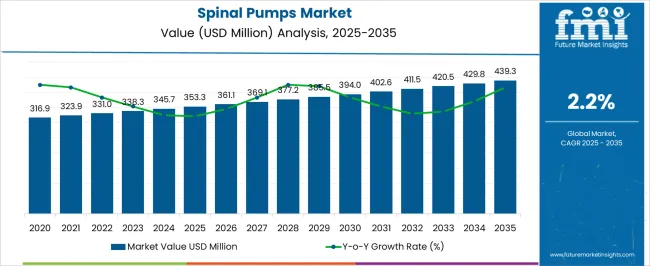
| Metric | Value |
|---|---|
| Spinal Pumps Market Estimated Value in (2025 E) | USD 353.3 million |
| Spinal Pumps Market Forecast Value in (2035 F) | USD 439.3 million |
| Forecast CAGR (2025 to 2035) | 2.2% |
The spinal pumps market is witnessing steady growth, driven by the rising prevalence of chronic pain conditions, spasticity disorders, and neurological diseases that require advanced pain management solutions. These pumps are increasingly preferred over systemic drug delivery because they provide targeted therapy directly into the spinal fluid, reducing side effects and improving patient quality of life. Growing adoption of minimally invasive treatment procedures, alongside advances in programmable pump technologies and drug delivery systems, is shaping the market.
Healthcare providers are prioritizing cost-effective solutions that reduce hospital stays and enhance long-term outcomes. Supportive reimbursement policies in developed regions, coupled with rising awareness in emerging markets, are further accelerating adoption.
Increasing investments in research and development are leading to innovations such as smaller, more reliable devices with extended battery life and advanced software integration With the growing demand for personalized medicine, spinal pumps are being recognized as an essential component of integrated pain management therapies, strengthening their role in both developed healthcare systems and expanding global markets.
The spinal pumps market is segmented by product type, end user, application, and geographic regions. By product type, spinal pumps market is divided into Implantable Pump With Continuous Flow and Implantable Pump With Bolus - Variable Flow. In terms of end user, spinal pumps market is classified into Hospitals, ASCs, Clinics, Long Term Care Centers, and Alternate Care Centers. Based on application, spinal pumps market is segmented into Failed Back Syndrome, Cancer Pain, Reflex Sympathetic Dystrophy (RSDS), Causalgia, Arachnoiditis, and Chronic Pancreatitis. Regionally, the spinal pumps industry is classified into North America, Latin America, Western Europe, Eastern Europe, Balkan & Baltic Countries, Russia & Belarus, Central Asia, East Asia, South Asia & Pacific, and the Middle East & Africa.
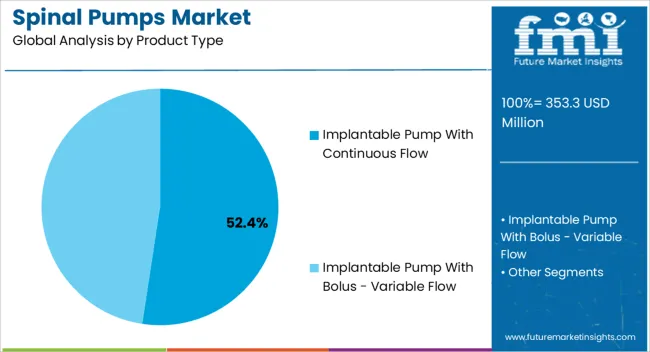
The implantable pump with continuous flow segment is projected to account for 52.4% of the spinal pumps market revenue in 2025, making it the leading product type. Its dominance is supported by the ability to provide consistent and controlled drug delivery directly into the intrathecal space, which enhances therapeutic outcomes and reduces systemic side effects. Patients with chronic pain or spasticity benefit from a reliable and steady flow of medication, improving long-term symptom management.
These pumps are particularly valued in cases where continuous delivery is essential for maintaining patient stability and reducing breakthrough pain episodes. Healthcare providers favor implantable continuous flow pumps because of their long-term efficiency, reduced need for frequent adjustments, and better compliance compared to alternative delivery methods.
Furthermore, technological improvements in implantable pumps, including longer battery life and enhanced programming capabilities, are reinforcing their adoption As the prevalence of chronic neurological conditions rises globally, the implantable pump with continuous flow segment is expected to remain a dominant force in the market.
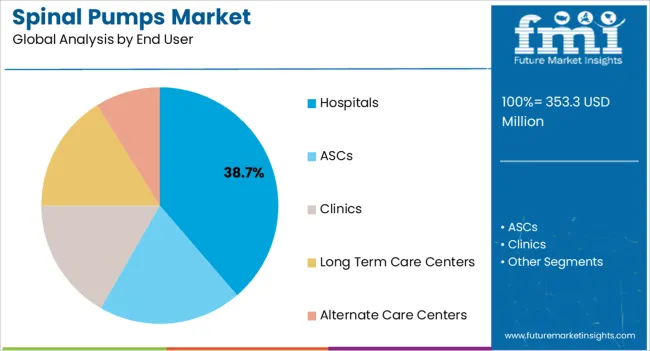
The hospitals segment is expected to hold 38.7% of the spinal pumps market revenue in 2025, establishing itself as the leading end user. Hospitals remain the primary centers for spinal pump implantation, follow-up care, and long-term monitoring of patients. The availability of specialized surgical expertise, advanced imaging facilities, and multidisciplinary teams in hospitals ensures optimal outcomes for patients undergoing spinal pump therapy.
Hospitals also play a critical role in managing complications, adjusting pump settings, and coordinating ongoing treatment plans, making them the preferred choice for patients with complex pain conditions. Increasing hospital-based clinical trials and research initiatives are further strengthening the segment’s importance. In addition, favorable reimbursement frameworks and insurance coverage for hospital-based procedures encourage patients to seek treatment in these facilities.
Hospitals are also adopting advanced electronic health record systems that integrate with spinal pump data, enabling better patient monitoring and outcomes analysis As patient demand for safe, specialized, and comprehensive care grows, hospitals are expected to maintain their leadership in the market.
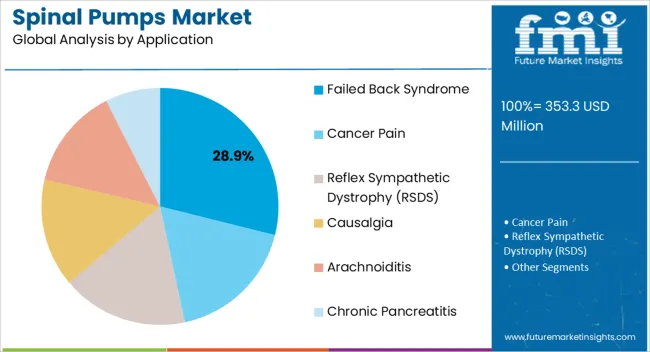
The failed back syndrome application segment is anticipated to account for 28.9% of the spinal pumps market revenue in 2025, making it the leading application area. Failed back syndrome, a condition characterized by persistent pain following spinal surgery, represents a significant clinical challenge that often necessitates advanced pain management approaches. Spinal pumps provide targeted intrathecal drug delivery, offering effective pain relief where conventional therapies may fail.
Continuous administration of analgesics directly into the spinal fluid minimizes systemic side effects and improves patient mobility and quality of life. The segment’s dominance is further supported by the rising incidence of spinal surgeries worldwide, which has contributed to a growing pool of patients with chronic post-surgical pain. Physicians are increasingly recommending spinal pumps as part of a comprehensive pain management strategy for these patients.
Advances in pump design and drug formulations are also enhancing treatment outcomes With healthcare providers prioritizing effective solutions for post-surgical complications, failed back syndrome is expected to remain the primary application driving market demand.
Intrathecal pumps or pain pumps are devices used to deliver medication directly into the spine. The system consists of small pump that is implanted surgically in the skin and delivers medication via catheter to the affected area around the spinal cord. The process of delivery of the medicine is similar to spinal anesthesia given during childbirth.
Drug delivery through this treatment option is adopted when all other treatment options didn’t provide any relief to the long-term or persistent symptoms. Drugs will be delivered directly to spinal cord and facilitates effective treatment through smaller drug dosages by oral route.
The implantable intrathecal drug pump facilitates quicker drug delivery and leads to faster relief. Rising adoption is expected to push market growth rates for pain infusion pumps.
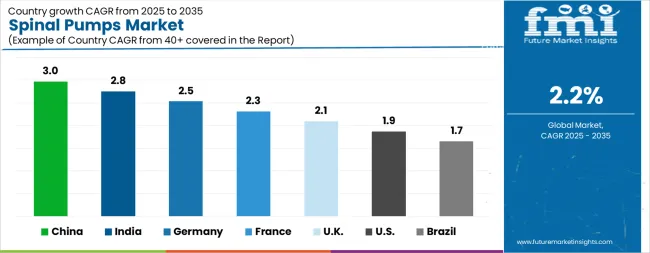
| Country | CAGR |
|---|---|
| China | 3.0% |
| India | 2.8% |
| Germany | 2.5% |
| France | 2.3% |
| UK | 2.1% |
| USA | 1.9% |
| Brazil | 1.7% |
The Spinal Pumps Market is expected to register a CAGR of 2.2% during the forecast period, exhibiting varied country level momentum. China leads with the highest CAGR of 3.0%, followed by India at 2.8%. Developed markets such as Germany, France, and the UK continue to expand steadily, while the USA is likely to grow at consistent rates. Brazil posts the lowest CAGR at 1.7%, yet still underscores a broadly positive trajectory for the global Spinal Pumps Market. In 2024, Germany held a dominant revenue in the Western Europe market and is expected to grow with a CAGR of 2.5%. The USA Spinal Pumps Market is estimated to be valued at USD 121.6 million in 2025 and is anticipated to reach a valuation of USD 146.4 million by 2035. Sales are projected to rise at a CAGR of 1.9% over the forecast period between 2025 and 2035. While Japan and South Korea markets are estimated to be valued at USD 15.9 million and USD 10.7 million respectively in 2025.
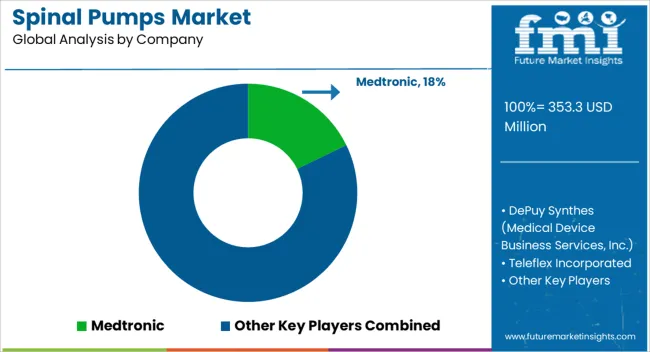
| Item | Value |
|---|---|
| Quantitative Units | USD 353.3 Million |
| Product Type | Implantable Pump With Continuous Flow and Implantable Pump With Bolus - Variable Flow |
| End User | Hospitals, ASCs, Clinics, Long Term Care Centers, and Alternate Care Centers |
| Application | Failed Back Syndrome, Cancer Pain, Reflex Sympathetic Dystrophy (RSDS), Causalgia, Arachnoiditis, and Chronic Pancreatitis |
| Regions Covered | North America, Europe, Asia-Pacific, Latin America, Middle East & Africa |
| Country Covered | United States, Canada, Germany, France, United Kingdom, China, Japan, India, Brazil, South Africa |
| Key Companies Profiled | Medtronic, DePuy Synthes (Medical Device Business Services, Inc.), Teleflex Incorporated, Smiths Group plc, FLOWONIX MEDICAL INC, Tricumed Medical Technology GmbH, Baxter, Globus Medical, DAIICHI SANKYO COMPANY, LIMITED., and Stryker |
The global spinal pumps market is estimated to be valued at USD 353.3 million in 2025.
The market size for the spinal pumps market is projected to reach USD 439.3 million by 2035.
The spinal pumps market is expected to grow at a 2.2% CAGR between 2025 and 2035.
The key product types in spinal pumps market are implantable pump with continuous flow and implantable pump with bolus - variable flow.
In terms of end user, hospitals segment to command 38.7% share in the spinal pumps market in 2025.
Explore Similar Insights

Thank you!
You will receive an email from our Business Development Manager. Please be sure to check your SPAM/JUNK folder too.
Chat With
MaRIA